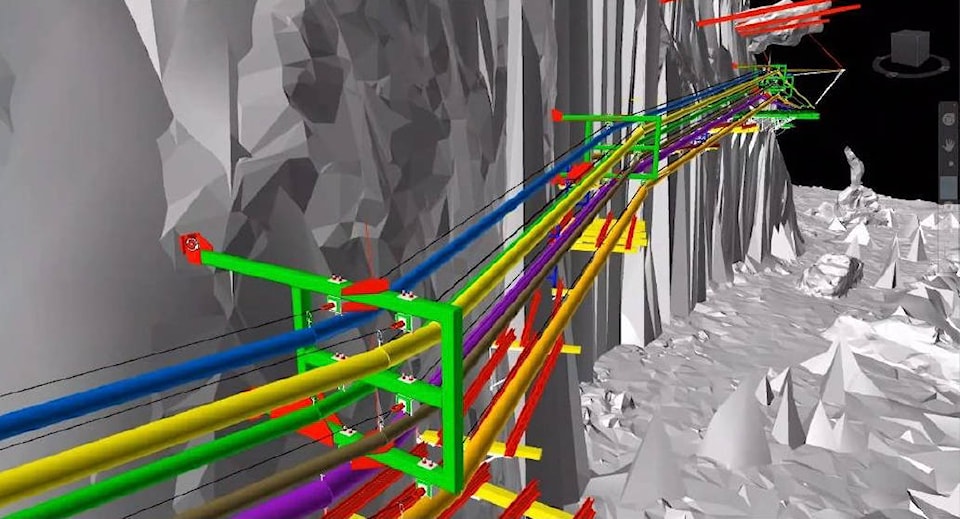By Jack Emberly/Special to The News
Whooshh? You imagine a clown fired out of a canon, but there’s a lot more to the Whooshh Fish Transport System (WFTS), or fish passage portal. It’s a sophisticated way of moving fish above obstacles – like dams – that kill them.
Or rockslides, like the one at Big Bar near Lillooet, which devasted Fraser River salmon in 2019 and could end future runs.
Some rock and boulders in the river – about 15 per cent - have been removed, but most of an estimated 75,000 cm is still there. More of that needs to come out to assure permanent passage to the northern two-thirds of the watershed.
In the meantime, Whooshh – able to move thousands of fish daily – will be employed. It will be up and running by Friday, June 12, says Gwil Roberts, landslide response director for the department of fisheries.
READ MORE: High tech fish transport system set up to ‘whoosh’ salmon past Big Bar landslide
That’s good news at the crucial eleventh hour.
Northern runs are declining, several near extinction. Official attempts to save them in 2019 didn’t work.
Let’s review. A three-meter-high waterfall halted migration.Transporting salmon upstream by helicopter and tanker truck, the traditional “trap and haul method,” predictably failed. Researchers in 2017 proved handling fish stressed them.
Salmon re-entered the Fraser, dazed and confused. Many swam down again. Of the 60,000 fish, department of fisheries and Oceans (DFO) moved, only three per cent survived.
Streamkeepers near Prince George feared they wouldn’t capture enough brood stock to run a small hatchery.
Fish that move naturally survive better. This year, a completed “nature-like” fishway on the the west side of the canyon will let them swim up on their own at lower water levels (3,200 cms or less). As the water level rises, Whooshh – mimicking nature – will click in.
PAST COLUMN ON THE ISSUES – ALONG THE FRASER: Lessons must be learned from Big Bar landslide
Salmon will enter a concrete fish ladder (500 interlocking blocks). From there, naturally running water will coax them to a holding pond. Next, a built-in scanner will assess fish for size. It determines which of six long, pressurized, pneumatic tubes of increasing diameters they’ll be pushed through, the largest tube, 25 cm in diameter, for chinook.
Once inside tubes, it’s 25 seconds to quieter water at roughly eight meters per second. Roberts says tubes are depressurized at the ends to assure the fish exit gently.
“This reduces stress to fish,” he said. “Last year, they’d been waiting below the slide for up to a month. Many battered themselves against the rocks. Mortality was extremely high. The Whooshh system is designed to eliminate human handling. This time there should be no mortalities.”
Saving Fraser River salmon at Big Bar will be costly. To their credit, the government has been willing to pay.
Last December, Peter Kiewit Sons was awarded a $17.6M contract for preparatory work at Big Bar. Everything had to be done between January and April, the short window before fish arrived.
“We knew we’d have to do more,” Roberts said.
“We contracted Kiewit for additional work to facilitate passage through a nature-like fishway and the installation of the Whooshh Fish Transport System. They had to access the site, build a road, remove rock, blast big boulders in the river to widen the channel, and blast an outcrop of rock on the river called the east toe. Kiewit had to bring in trucks and heavy excavators and removed as much as possible. That part’s been done.”
Ongoing site safety had to be assured.
“Kiewit has installed additional rock fall mesh at multiple locations and stabilization curtain along the west beach slope,” said Roberts.
On May 13, the company added a shift to work on the infrastructure.
Crews erected a platform needed to allow work on the tubing system. It’s suspended by hangers attached to the cliff wall. Pullies, remotely controlled, allow tubes to be lowered or raised depending on water levels.
MORE: Feds to move salmon over Big Bar landslide with fish cannon along Fraser River
Costs have subsequently risen to more than $52M. This does not include the Whooshh system. It’s leased until the end of migration in October – with an option to buy.
Again, it’s crucial to plan and act quickly.
Whooshh says its “transformational” system “can be an environmental solution for hundreds of dams.”
In 2018, the company told a committee of local stakeholders including ARMS, First Nations, the DFO, and Ministry of the Environment, the WFTS could be a solution to kokanee trapped behind the Alouette dam.
On June 2, Greta Borick-Cunningham of ARMS, told me the group didn’t see Whooshh as a permanent solution because fish would still be destroyed in entrainment tunnels that divert water to generators for electricity, or in the turbines the tunnels supplied with water.
Still, the system could be used “to see what salmon we could send over the dam.”
Whooshh Innovations claim its costs are 80 per cent less than other options including ladders.
They’re being used at dams in the U.S.
It says the system is “modular, adaptable, and portable – minimizing costly civil work,” and “remote monitoring lowers maintenance and operation costs.”
Whooshh Innovations offer financing.
DFO is studying its options.
To quote Whooshh, “fish and our planet have no time to lose.”
.
– Jack Emberly is a retired teacher, local author, and environmentalist
.
• If there is more to this story, please let us know about it. Email us at editor@mapleridgenews.com. We look forward to hearing from you. In the meantime, like us on Facebook or follow us on Twitter.
